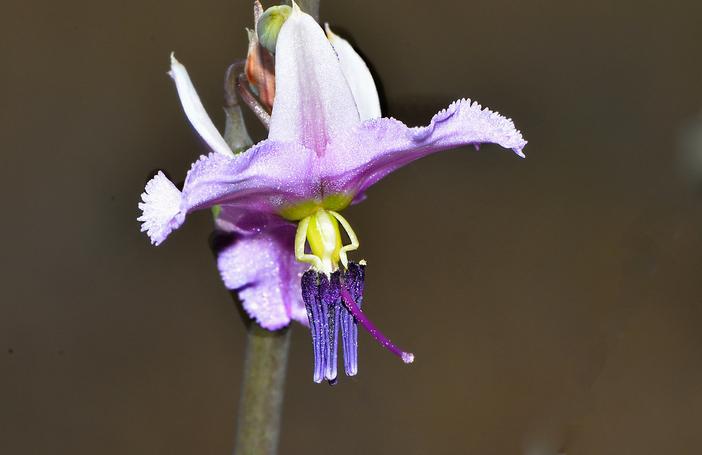Chocolate Lily
(Dichopogon fimbriatus)
Chocolate Lily (Dichopogon fimbriatus)
/
/

Jean and Fred Hort
CC BY 2.0
Image By:
Jean and Fred Hort
Recorded By:
Copyright:
CC BY 2.0
Copyright Notice:
Photo by: Jean and Fred Hort | License Type: CC BY 2.0 | License URL: https://creativecommons.org/licenses/by/2.0/ | Uploader: jeans_Photos | Publisher: Flickr





























Estimated Native Range
Summary
Dichopogon fimbriatus, commonly known as Chocolate Lily, is a deciduous perennial herb native to a variety of habitats including open woodlands, grasslands, and savannahs in Southeastern and Southwestern Australia. It typically grows to a height of 2-3 feet (0.6-0.9 meters) and a width of 0.3-0.6 feet (0.09-0.2 meters). The plant features grass-like leaves and produces distinctive, nodding flowers that are chocolate-scented, with colors ranging from pink to deep purple, during the late fall and winter months. The flowers are particularly showy due to their unique color and fragrance.
The Chocolate Lily is valued for its aromatic flowers which can add a unique sensory experience to gardens. It is often used in naturalistic plantings, borders, and as an understorey plant in shaded areas. This species is relatively easy to maintain, requiring medium amounts of water and thriving in a range of soil types, provided they have good drainage. It prefers full sun to part shade conditions. While generally disease-free, it can be susceptible to root rot in overly wet soils. The Chocolate Lily is not known for aggressive roots or significant pest problems. It is also appreciated for its ability to attract pollinators such as bees.CC BY-SA 4.0
The Chocolate Lily is valued for its aromatic flowers which can add a unique sensory experience to gardens. It is often used in naturalistic plantings, borders, and as an understorey plant in shaded areas. This species is relatively easy to maintain, requiring medium amounts of water and thriving in a range of soil types, provided they have good drainage. It prefers full sun to part shade conditions. While generally disease-free, it can be susceptible to root rot in overly wet soils. The Chocolate Lily is not known for aggressive roots or significant pest problems. It is also appreciated for its ability to attract pollinators such as bees.CC BY-SA 4.0
Plant Description
- Plant Type: Herb
- Height: 1.5-3 feet
- Width: 0.3-0.6 feet
- Growth Rate: Moderate
- Flower Color: Purple, Red
- Flowering Season: Fall, Winter
- Leaf Retention: Deciduous
Growth Requirements
- Sun: Full Sun
- Water: Medium
- Drainage: Slow, Medium, Fast
Common Uses
Edible*Disclaimer: Easyscape's listed plant edibility is for informational use. Always verify the safety and proper identification of any plant before consumption., Low Maintenance, Showy Flowers
Natural Habitat
native to a variety of habitats including open woodlands, grasslands, and savannahs in Southeastern and Southwestern Australia
Other Names
Common Names:
Scientific Names: , Dichopogon fimbriatus, Arthropodium fimbriatum, Arthropodium laxum, Dichopogon sieberianus, Anthericum fimbriatum, Dichopogon undulatus, Dicopogon laxum, Siona fimbriata, Siona fimbriata publ,
GBIF Accepted Name: Dichopogon fimbriatus (R.Br.) J.F.Macbr.